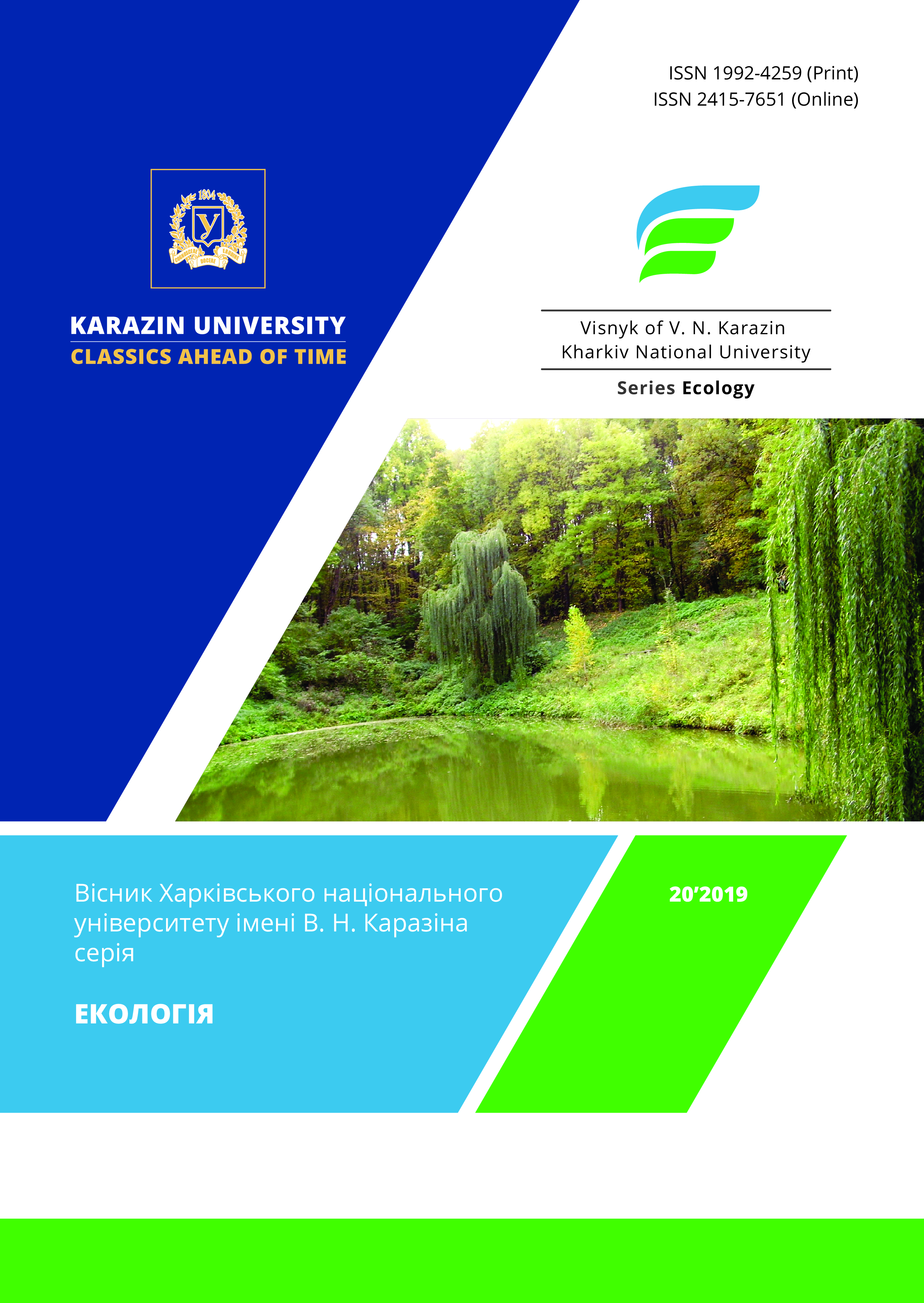Протиерозійна оптимізація території аграрних господарств на прикладі Харківської області, Україна
Анотація
Мета. Показати послідовність дій по протиерозійній оптимізації структури землекористування на прикладі агропідприємств Харківської області та подальші шляхи підвищення її ефективності. Методи. Картографічні, статистичні, геоінформаційного аналізу, математичного моделювання, магніторозвідка. Результати та висновки. Показаний приклад протиерозійної оптимізації землекористування на основі математичного моделювання потенційного змиву ґрунту за різних умов землекористування для трьох типових фермерських господарств Харківської області (Україна). Моделювання проводили за моделлю Ц. Мірцхулави із використанням цифрових моделей рельєфу в середовищі ArcGIS. Використання ГІС для проведення моделювання та візуалізації результатів дозволяє виділити найбільш ерозійно небезпечні ділянки та здійснити індивідуальний підбір сівозмін для кожного господарства. Виявлена в результаті моделювання потенційна загроза ерозії може бути попереджена за допомогою організаційних та агротехнічних заходів, що потребує від господарства мінімальних економічних витрат. Запропоновано шляхи перевірки ефективності агролісомеліоративних заходів з застосуванням методів та засобів магніторозвідки. Висновки. Протиерозійна оптимізаціяземлекористування дозволяє досягти допустимих значень змиву ґрунту на всіх полях досліджених господарств. При цьому втрати ґрунту зменшуються, залежно від початкового рівня небезпеки та ступеня трансформації сівозміни від 10 % на схилах до 1,5º, до 4,2 разів на ускладнених ділянках.
Завантаження
Посилання
Transforming our world: the 2030 Agenda for Sustainable Development (2015). Available at: https://sustainabledevelopment.un.org/post2015/transformingourworld
Land Degradation Neutrality Target Setting – A Technical Guide. (2016). Available at:https://www.unccd.int/sites/default/files/inline-files/LDN%20TS%20Technical%20Guide_Draft_English.pdf
Lynden, G. W. J. van.(1997). Guidelines for the Assessment of Soil Degradation in Central and Eastern Europe (Soveur Project). Wageningen : ISRIC. 22 .
Balyuk, S.A., Medvedyev, V.V., Miroshnychenko, M.M. (Ed.) (2018). Koncepciyi dosyagnennya nejtral`nogo rivnya degradaciyi zemel` (g`runtiv) Ukrayiny` [Conceptions of achieving a neutral level of land degradation (soil) of Ukraine]. Kharkiv: FOP Brovin O.V. (in Ukrainian)
Titenko, G. V., Medvedev, V. V. (2018). Rol` g`runtovogo pokry`vu v opty`mizaciyi social`noyi polity`ky` Ukrayiny` [The role of soil cover in optimizing the social policy of Ukraine]. Visnyk of V. N. Karazin Kharkiv National University series «Еcоlogy», 18, 14-21. (in Ukrainian)
Kil`kist` sil`s`kogospodars`ky`x pidpry`yemstv i ploshha sil`s`kogospodars`ky`x ugid` u yixn`omu kory`stuvanni stanom na 1 ly`stopada 2017 roku za regionamy`[The number of agricultural enterprises and the area of agricultural land in their use as of November 1, 2017 by regions]. Available at:http://www.ukrstat.gov.ua/ (in Ukrainian)
Kucenko, M.V. (2014) Kompleksna prostorova opty`mizaciya struktury` sil`s`kogospodars`ky`x ugid`: regional`ny`j riven` [Integrated spatial optimization of the structure of agricultural land: regional level Visnyk of V. N. Karazin Kharkiv National University series «Еcоlogy», (1104(10)), 99-105. (in Ukrainian)
Kolyada, V. P., Shevchenko, M. V., Kruhlov, O. V. Et all. (2018). Proty`erozijna opty`mizaciya zemlekory`stuvannya sil`s`kogospodars`ky`x pidpry`yemstv: lokal`ny`j riven` [Anti-erosion optimization of land use of agricultural enterprises: local level.] Man and environment. Issues of neoecology, (1-2 (29)), 57-63. (in Ukrainian)
Nazarok, P.G., Kruglov, O.V., Kucenko, M.V. ta in. (2015). Do py`tannya kartografuvannya yerozijny`x procesiv [On the mapping of erosional processes]. Bulletin of Agricultural Science, 9, 63-68. (in Ukrainian)
Menshov, O., Kruglov, O., Sukhorada, A. (2012) Informational content of the soil magnetism indicators for solving agrogeophysical and soil science tasks. Scientific Bulletin of the National mining University. 3, 7-12.
DSTU 7904:2015. (2016) Yakist` g`runtu. Vy`znachennya potencijnoyi zagrozy` eroziyi pid vply`vom doshhiv. [The quality of the soil. Determination of the potential threat of erosion under the influence of rain]. Official edition, Kyiv, 12. (in Ukrainian)
Vadyuny`na, A.F., Korchagy`na, Z.A. (1986) Metodi y`ssledovany`ya fy`zy`chesky`x svojstv pochv [The methods for studying the physical properties of soils]. Moscow: Agropromy`zdat, 416. (in Ukrainian)
Pro zatverdzhennya Metody`chny`x rekomendaciyi shhodo rozroblennya proektiv zemleustroyu, shho zab-ezpechuyut` ekologo-ekonomichne obg`runtuvannya sivozminy` ta vporyadkuvannya ugid (2013). [On approval of the Methodological recommendations for the development of land management projects that provide ecological and economic rationale for crop rotations and farmland management]. Order of State Agency of Land Resources of Ukraine.02.10.2013 № 396. Land Bulletin. 10, 52 - 63. (in Ukrainian)
Morgun, F.T., Shy`kula, N.K., Tarary`ko, A.G. (1988). Pochvozashhy`tnoe zemledely`e. [Soil-protecting agriculture]. Kiyv, 256. (in Ukrainian)
Menshov, О., Kruglov, O., Vyzhva, S. (2018). Magnetic methods in tracing soil erosion, Kharkov Region, Ukraine. Studia Geophysica et Geodaetica. 62. 681-696, doi: 10.1007/s11200-018-0803-1-681
Автори, які публікуються у цьому журналі, погоджуються з наступними умовами:
- Автори залишають за собою право на авторство своєї роботи та передають журналу право першої публікації цієї роботи на умовах ліцензії Creative Commons Attribution License 4.0 International (CC BY 4.0), котра дозволяє іншим особам вільно розповсюджувати опубліковану роботу з обов'язковим посиланням на авторів оригінальної роботи та першу публікацію роботи у цьому журналі.
- Автори мають право укладати самостійні додаткові угоди щодо неексклюзивного розповсюдження роботи у тому вигляді, в якому вона була опублікована цим журналом (наприклад, розміщувати роботу в електронному сховищі установи або публікувати у складі монографії), за умови збереження посилання на першу публікацію роботи у цьому журналі.
- Політика журналу дозволяє і заохочує розміщення авторами в мережі Інтернет (наприклад, у сховищах установ або на особистих веб-сайтах) рукопису роботи, як до подання цього рукопису до редакції, так і під час його редакційного опрацювання, оскільки це сприяє виникненню продуктивної наукової дискусії та позитивно позначається на оперативності та динаміці цитування опублікованої роботи (див. The Effect of Open Access).





